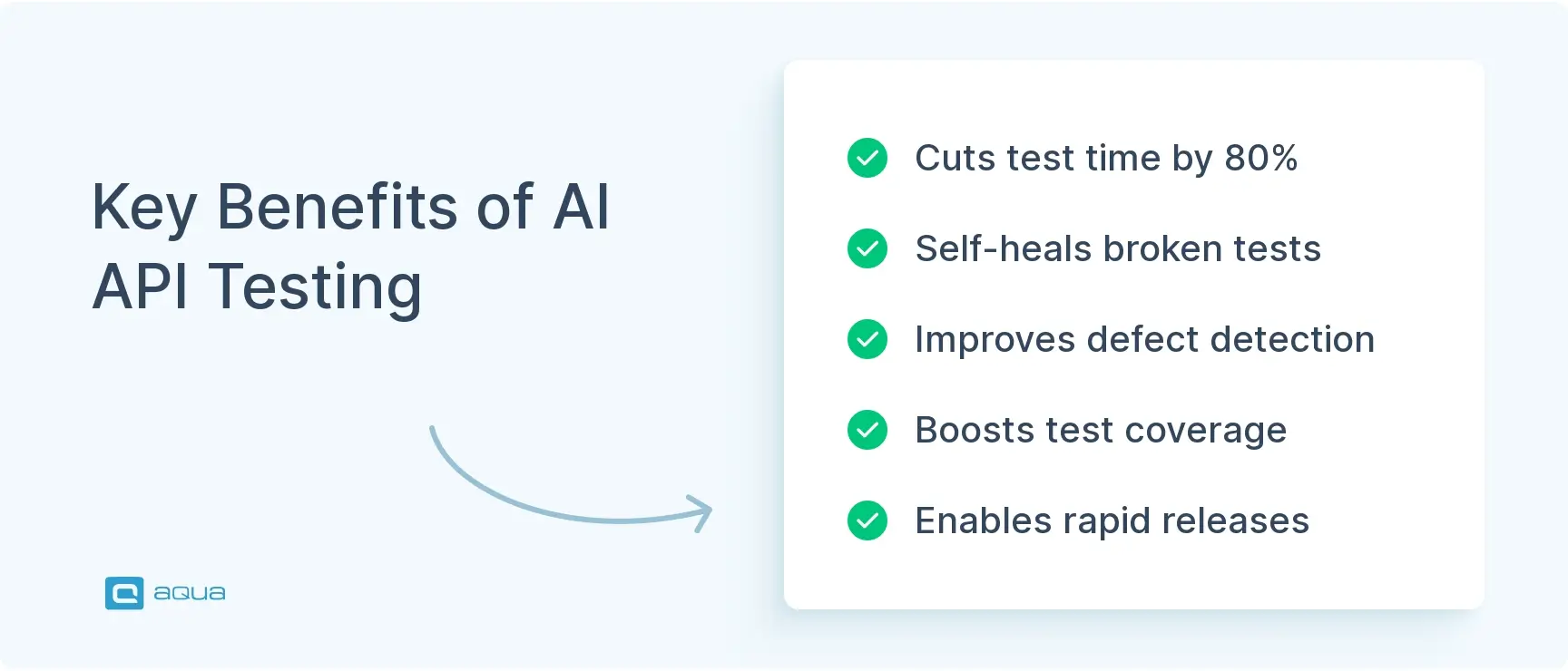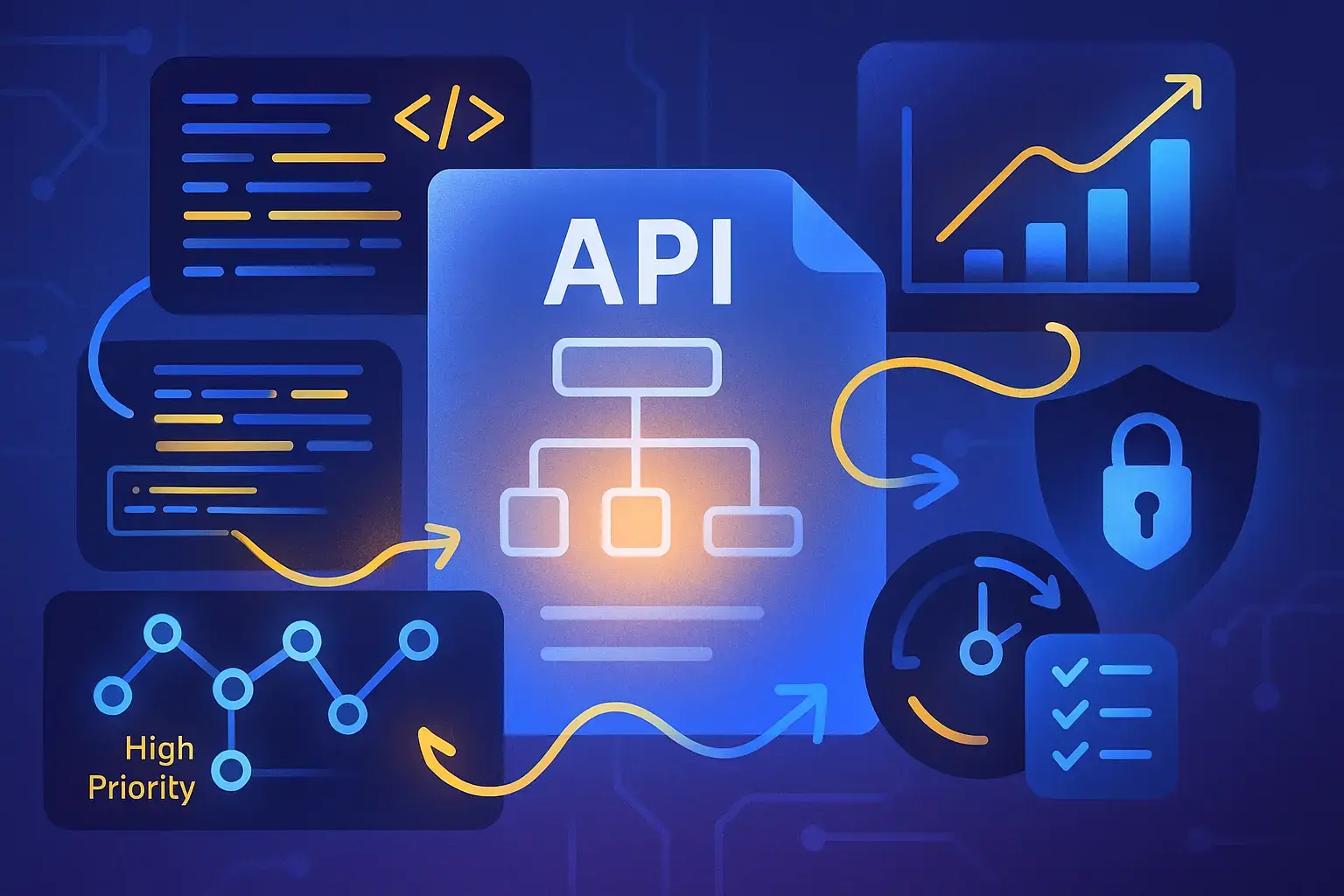Key Takeaways
- AI-driven API testing automates test creation, execution, and maintenance by learning from API specifications and usage patterns to adapt tests dynamically.
- Self-healing test capabilities reduce maintenance overhead by up to 70% as tests automatically adapt when API signatures change.
- AI testing tools identify edge cases and potential security vulnerabilities that human testers often miss, improving defect detection rates by 30-50%.
- Implementation works best when starting with a single non-critical API as a pilot before gradual expansion across your testing ecosystem.
- Teams using AI-driven API testing report 60-80% reduction in test creation time and 2-3x faster overall testing cycles compared to traditional methods.
While traditional API testing struggles to keep pace with microservices that change daily, AI-powered approaches flip the script by adapting to your code instead of breaking with every update. Discover which tools deliver on these promises and how to implement them successfully 👇
API Testing Evolution
Ten years ago, API testing meant manually crafting HTTP requests in Postman and eyeballing the responses. Today’s teams deploy hundreds of microservices that change daily. Manual testing doesn’t scale to this complexity. The progression happened fast:
- Manual era (pre-2010): Engineers manually constructed requests, analysed responses, and documented results
- First-wave automation (2010-2015): Script-based testing frameworks emerged, allowing teams to automate basic test cases
- API-specific tools (2015-2020): Dedicated API testing platforms with visual interfaces reduced coding requirements
- AI integration (2020-present): Machine learning algorithms began enhancing test creation, execution, and maintenance
The push toward AI in software testing is driven by real market pressures.
Release cycles went from quarterly to daily. Enterprise companies now run 900+ applications with thousands of API endpoints. Teams spend 70% of their testing time fixing broken tests instead of finding new bugs. Microservices architecture makes API dependencies so complex that manual validation becomes impossible.QA teams face a choice: evolve or become bottlenecks. Traditional testing methods can’t keep up with the modern development speed. Teams that embrace AI in software testing maintain quality while staying fast. Teams that don’t get left behind.
What is AI API Testing?
Now, let’s narrow down our definition to AI API Testing.AI API testing uses machine learning to validate APIs automatically. Instead of writing static test scripts that break every time an endpoint changes, AI learns your API behaviour and adapts tests on the fly.Traditional API testing requires you to predict every possible scenario. Change a field name? Rewrite your tests. Add a new parameter? Update dozens of test cases. AI testing flips this approach and generates tests based on your API specs, learns from real usage patterns, and evolves with your code. At its core, AI API testing uses algorithms to:
- Generate test cases automatically based on API specifications and usage patterns
- Identify potential regression issues before they impact users
- Adapt to API changes without requiring complete test rewrites
- Optimise test execution by prioritising critical test paths
- Analyse test results and suggest improvements
The shift changes how you work. Instead of writing and maintaining hundreds of test scripts, you guide AI systems and analyse results. Instead of fixing broken tests after every API change, you focus on finding real bugs and improving coverage.
How is API testing improved with artificial intelligence?
AI tackles the biggest problems in API testing: slow test creation, constant maintenance, and missing edge cases. But that’s not it, there are more. Here’s how it changes each part of the testing process:
Automated Test Generation
Writing comprehensive API tests manually takes forever. You analyse documentation, map out parameter combinations, and script each test case. Miss an edge case? That’s a production bug waiting to happen.
With AI:
- Machine learning algorithms analyse API specifications and automatically generate test cases
- AI identifies optimal parameter combinations for more thorough test coverage
- Test generation time drops from days to minutes for complex APIs
- Coverage improves as AI identifies edge cases humans might overlook
Self-Healing Test Maintenance
API changes break traditional tests constantly. Someone renames a field, adds a parameter, or changes response structure, and your test suite explodes with failures. Teams spend entire sprints fixing tests instead of testing new features.
With AI:
- Tests automatically adapt when API signatures change
- Machine learning models recognise patterns in API behaviour to maintain test validity
- Maintenance overhead decreases by up to 70%
- Release delays due to test maintenance virtually disappear
Intelligent Test Execution
Running every test for every change wastes time and resources. Critical bugs hide behind slow test suites that developers learn to ignore.
With AI:
- Smart prioritisation runs tests most likely to fail first
- Test execution time decreases by 40-60%
- Resources are allocated more efficiently
- Results reach developers faster, speeding up the feedback loop
Enhanced Performance Testing
Traditional performance tests use static load patterns that don’t match real usage. You set artificial thresholds and hope they’re reasonable. Problems surface in production when actual user patterns differ from your assumptions.
With AI:
- Dynamic load generation based on real-world usage patterns
- Anomaly detection identifies performance issues before they become critical
- AI models predict performance under various conditions
- Root cause analysis becomes automated rather than manual
Security Testing Augmentation
Security testing typically checks known vulnerability patterns. New attack vectors slip through because you can’t test for threats you don’t know exist.
With AI:
- Machine learning identifies potential security threats based on evolving patterns
- Zero-day vulnerabilities become easier to detect
- Continuous security assessment becomes feasible
- Remediation recommendations become more precise
The efficiency gains are substantial. According to research, teams implementing AI-driven API testing report:
- 60-80% reduction in test creation time (even more with solutions like aqua cloud)
- 40-70% reduction in test maintenance effort
- 30-50% improvement in defect detection rates
- 2-3x faster overall testing cycles
This translates to AI test automation benefits: faster releases, better quality, and dramatically reduced testing costs over time.
As we explore the evolution of API testing and the transformative impact of AI, it’s clear that you need comprehensive solutions that support both manual and automated testing workflows. While identifying the right API testing tools is crucial, having a centralised test management platform can substantially amplify your testing effectiveness.
aqua cloud offers exactly that – a unified platform where AI-powered test management meets seamless integration with API testing tools.With aqua’s AI capabilities, you can generate comprehensive test cases from requirements in seconds, including those covering API functionality. The platform enables you to manage both manual and automated API tests side-by-side, providing complete visibility and real-time traceability across your testing ecosystem. By integrating with popular API testing tools like SoapUI, (also non-API tools like Jira, Confluence, Azure DevOps) aqua cloud brings all your test results into a single source of truth, ensuring nothing falls through the cracks. This not only streamlines your API testing workflows but also accelerates your overall testing cycles with AI-powered test prioritisation and data generation.
Achieve 100% transparent test coverage and save up to 98% of time spent on test creation and maintenance with aqua cloud
Advantages and challenges of AI API testing
AI API testing delivers significant advantages, but implementation isn’t without challenges. Understanding both sides helps you make realistic decisions about adoption.
Advantages
Here are the main benefits AI API testing brings to the table:
- Reduced manual effort: AI automates repetitive testing tasks, freeing up QA engineers for more complex problems
- Improved test coverage: Machine learning identifies edge cases and creates tests humans might miss
- Faster test creation: Generate comprehensive test suites in minutes instead of days or weeks
- Lower maintenance costs: Self-healing tests adapt to API changes automatically
- Better defect detection: AI can spot subtle patterns and anomalies that indicate problems
- Scalability: Easily scale testing as API complexity grows
- Continuous testing support: Seamlessly integrates with CI/CD pipelines for constant quality checks
- Predictive insights: Some AI tools can predict where defects are likely to occur
- Natural language processing: Create tests using plain English rather than complex code
Challenges
And here are the probable challenges you will face when applying AI API testing, especially for the first few times:
- Initial setup complexity: Implementing AI testing systems requires expertise and configuration
- Training period: AI systems need time to learn your APIs and testing patterns
- Cost considerations: Advanced AI testing tools often come with higher price tags
- Trust issues: Teams may hesitate to rely fully on AI-generated tests
- Integration hurdles: Making AI testing work with existing tools and processes
- Skills gap: Finding team members with both testing and AI expertise
- Black box concerns: Understanding why AI makes certain testing decisions
- Data requirements: AI needs sufficient historical test data to be most effective
- Over-optimisation risk: AI might optimise for test passing rather than finding bugs
Knowing both sides of the coin is equally important, so you can fully grasp the best implementation practices we talk about next.

How to implement AI API testing step-by-step
Most teams approach AI testing wrong: they try to replace everything at once and get overwhelmed. Smart implementation starts small and builds confidence through early wins. Start by evaluating your current testing pain points. Which APIs break tests most often when they change? Which endpoints have the most complex validation logic? Which test suites take the longest to maintain? These become your candidates for AI testing. Pick one non-critical API for your pilot. Something important enough to matter but not so critical that failure kills your product. Set measurable goals:
- Reduce test maintenance time by 50%
- Increase test coverage by 30%
- Cut test creation time from days to hours.
Choose your AI testing tool based on practical factors. Does it integrate with your existing CI/CD pipeline? Can your team learn it without six months of training? Does it support your API types: REST, GraphQL, or whatever you’re actually using? Don’t chase the most advanced features if they don’t solve your immediate problems. Feed the AI good data from the start:
- Upload your OpenAPI specs
- Include existing test cases
Provide examples of real API calls and responses. The better your initial data, the faster AI learns your patterns. Poor data leads to poor tests that nobody trusts. Run AI tests alongside your existing tests initially. Compare results for several weeks. Are AI tests catching bugs that your manual tests miss? Are they producing false positives? This parallel approach builds team confidence and reveals gaps in either testing approach. Configure self-healing carefully. Set conservative thresholds for automatic test updates. When AI modifies a test, you want clear reporting on what changed and why. Teams that allow too much automatic change lose trust quickly when something goes wrong. Integrate gradually with your CI/CD pipeline. Start by running AI tests nightly instead of on every commit. As reliability improves, move toward real-time execution. Configure appropriate failure thresholds; you don’t want flaky AI tests blocking deployments. Monitor what matters:
- Test quality over time
- Maintenance overhead reduction
- Actual bug detection rates
- ROI by measuring time saved versus tool costs.
Document successes and failures to guide expansion decisions. Expand methodically once your pilot succeeds. Add one API at a time to AI testing coverage. Increase test complexity gradually. Train your team on advanced features only after they master the basics. Rush the rollout, and you’ll create resistance instead of adoption.
If the APIs evolve rapidly, it makes them hard to use as a real user if they're constantly changing. APIs should be relatively stable and consistent, or else they fail as APIs.
AI-Driven API Testing vs. Traditional API Testing
Now let’s look at how the AI-driven approach differs (also overcomes) the traditional method, and in what ways:
| Aspect | Traditional API Testing | AI-Driven API Testing |
|---|---|---|
| Test Creation | Manual scripting based on API documentation | Automated generation from specs and usage patterns |
| Setup Time | Days to weeks for comprehensive coverage | Hours to days for similar coverage |
| Maintenance | High effort; tests break when APIs change | Low effort; self-healing tests adapt to changes |
| Test Coverage | Limited by tester time and expertise | Comprehensive; AI identifies edge cases |
| Edge Case Detection | Relies on tester creativity | Uses pattern recognition and data analysis |
| Execution Speed | Sequential or basic parallel execution | Intelligent prioritization and optimization |
| Resource Requirements | More human hours, less computing power | Less human intervention, more computing resources |
| Skill Requirements | API testing expertise | Testing fundamentals + AI configuration skills |
| Test Script Readability | Usually high (when well-documented) | Varies by tool; can be less transparent |
| Cost Structure | Higher ongoing labor costs | Higher initial investment, lower maintenance costs |
| CI/CD Integration | Requires custom scripting | Native integration with modern pipelines |
| Learning Curve | Moderate for testers | Steeper initially, shallower once implemented |
| Adaptability to Changes | Low; requires manual updates | High; automatically adjusts to many changes |
| Root Cause Analysis | Manual investigation | AI-assisted pattern recognition |
These differences matter most when you have complex APIs that change often. If your APIs are simple and stable, traditional testing works fine. AI testing pays off when maintenance overhead eats your time, test coverage has gaps, or slow testing blocks releases. The choice depends on your specific problems, not which technology sounds more impressive.
API Regression testing automation with AI
Regression testing ensures that new code changes don’t break existing functionality; it’s critical for APIs that often serve as the backbone for multiple applications. AI changes how regression testing works by making it smarter and less maintenance-heavy.
With AI-driven web API testing, the process looks like this:
AI analyses API changes to determine impact scope. Rather than blindly running all tests, it prioritises tests affected by recent code changes. This approach drastically reduces test execution time while maintaining confidence in the results.
Machine learning models track historical test data, identifying which tests frequently catch issues for specific types of changes. This intelligence helps focus testing efforts where problems are most likely to occur.
The most significant advantage comes from self-healing capabilities. When an API changes (parameter name updates, new required fields, changed response structures), AI-powered tests can automatically:
- Detect the change pattern
- Update test scripts accordingly
- Continue testing without human intervention
- Report the adaptation for review
This self-healing mechanism dramatically reduces false failures that plague traditional regression testing. In conventional setups, even minor API changes can trigger cascades of test failures that require manual fixes. With AI, these “maintenance failures” largely disappear.
For QA teams, this means:
- Less time fixing broken tests
- More consistent test coverage
- Faster feedback on real issues
- Reduced regression testing bottlenecks
The automation cycle becomes largely self-sustaining, with the AI continuously improving its understanding of your API behaviour patterns and adapting tests accordingly.
CI/CD Pipeline and AI-Driven API Testing
When your team is pushing code changes constantly, sometimes dozens of times a day, your testing needs to move just as fast. The old way of running every single test for every tiny change does not work anymore. Here’s how AI-driven API testing typically integrates with CI/CD workflows:
- Code commit triggers: When developers push changes, AI testing tools automatically analyze the changes to determine which API tests need to run.
- Smart test selection: Rather than running all tests for every change, AI selects relevant test subsets based on the code changes, dramatically reducing test execution time.
- Parallel execution: Tests run simultaneously across cloud resources, further speeding up the feedback cycle.
- Real-time results analysis: AI analyses test results as they come in, categorising failures and identifying patterns.
- Feedback loops: Test results are immediately communicated back to developers, often with AI-generated insights about failure causes.
- Deployment gates: Based on testing results and risk analysis, AI can recommend whether to proceed with deployment.
The benefits of this integration are evident:
- Rapid feedback cycles: Developers learn about potential issues minutes after committing code
- Reduced wait times: Testing no longer delays deployment pipelines
- Higher confidence: More comprehensive testing without increased time costs
- Focused attention: Developers only need to address real issues, not test maintenance
- Documented quality: Each release includes comprehensive API quality metrics
The most advanced implementations take this further with “quality intelligence”: AI systems that not only test but also learn from historical patterns to predict where issues might occur in future releases.
For QA teams, this integration means shifting from a test execution role to a quality governance role, focusing on test strategy rather than test mechanics. The AI handles execution details while human expertise guides overall quality direction.
Best AI tools for API testing
You’ve seen what smart API testing can do. Now you probably want to know which tools can actually deliver on these promises. Fair warning: not all “AI-powered” testing tools are created equal. Some slap machine learning onto basic automation and call it revolutionary. Others genuinely change how you think about testing.Each tool has a different philosophy about how AI should help with testing. Some focus on generating tests from your existing API traffic. Others excel at spotting the subtle bugs that slip through traditional testing. A few try to do everything, which sometimes means they don’t excel at anything. What you should focus on when choosing a dedicated API testing tool:
- Does it actually save time, or just move the work around?
- Can it handle real-world APIs with authentication, rate limits, and inconsistent responses?
- When it finds problems, does it give you enough context to fix them quickly?
- How much babysitting does it need once you get it running? Let’s start.
Testim API Testing
Testim combines AI-powered test generation with robust self-healing capabilities. Its biggest strength is how it learns from your API usage patterns to create increasingly accurate tests over time.
Key features:
- Natural language test creation
- Automatic test maintenance
- Visual test builder with AI suggestions
- Strong integration with frontend testing
Best for: Teams that need both API and UI testing in one platform.
Applitools for APIs
Known primarily for visual testing, Applitools has expanded its AI capabilities to API testing with impressive results. Their unique approach uses visual representations of API responses to detect subtle changes.
Key features:
- Visual API response comparison
- Anomaly detection in complex data structures
- Root cause analysis through AI pattern recognition
- Seamless integration with existing test frameworks
Best for: Teams already using Applitools for frontend testing.
Sauce Labs API Testing
Sauce Labs has built powerful AI features into its comprehensive testing cloud. Their machine learning models excel at predicting which tests are most likely to fail based on code changes.
Key features:
- Smart test selection and prioritization
- Cross-platform compatibility verification
- Performance anomaly detection
- Security vulnerability scanning
Best for: Enterprise teams needing comprehensive testing across platforms.
Postman + Newman with AI Extensions
While Postman itself isn’t an AI tool, several AI extensions now enhance its capabilities. These add-ons bring intelligent test generation and maintenance to the platform most API developers already know.
Key features:
- AI-generated test assertions based on response patterns
- Test suite optimisation recommendations
- Automatic documentation generation
- Collection healing for changed APIs
Best for: Teams already invested in the Postman ecosystem.
Qyrus AI
A newer entrant focused exclusively on AI-powered API testing. Qyrus stands out for its codeless approach and natural language interface.
Key features:
- Conversation-based test creation
- API discovery and mapping
- Predictive test maintenance
- Comprehensive performance analytics
Best for: Teams looking for a fully AI-native testing solution.
IBM Watson-powered API Testing
IBM’s AI powerhouse Watson now offers specialised API testing capabilities with deep analytical features that excel at finding complex bugs.
Key features:
- Advanced pattern recognition for anomaly detection
- Natural language test creation and management
- Comprehensive API security testing
- Sophisticated analytics dashboard
Best for: Large enterprises with complex API ecosystems.
Mabl API Testing
Mabl has expanded from UI testing into the API space with an intelligent testing platform that emphasises ease of use and quick setup.
Key features:
- Low-code test creation with AI assistance
- Auto-healing test scripts
- Intelligent alerting for API degradation
- Strong CI/CD integrations
Best for: Teams wanting quick implementation with minimal configuration.
As API testing evolves with AI, choosing the right toolset becomes critical for maintaining quality while keeping pace with rapid development cycles. While dedicated API testing tools offer specialised capabilities, they often create silos that complicate test management and reduce visibility. This is where aqua cloud provides the perfect complement to your API testing strategy.
aqua cloud serves as the central nervous system for your entire testing ecosystem, seamlessly integrating with your preferred API testing tools while adding powerful AI capabilities. With aqua’s AI Copilot, you can instantly generate comprehensive test cases from requirements, automatically create test data, and ensure complete traceability between requirements and tests. The platform’s unified approach means you can manage both manual and automated API tests in one place, with real-time dashboards that give stakeholders complete visibility into quality metrics. What sets aqua apart is how it bridges the gap between API testing tools and your broader quality strategy. By centralising test management and leveraging AI to automate repetitive tasks, aqua helps teams achieve up to 98% time savings while ensuring nothing is missed. The REST API enables easy integration with any tool in your API testing pipeline, making aqua cloud the ideal foundation for implementing the AI-driven API testing approaches discussed in this article.
Transform your API testing strategy with unified test management and AI-powered efficiency
Now that you know the tools you need for specific pain points, let’s see where AI API testing is heading.
Future trends in AI API testing
The changes happening now are just the beginning. Here’s what we’re actually going to see in the next few years: not sci-fi predictions, but stuff that’s already being built in labs and beta programs.
Testing that warns you before things break
Instead of finding bugs after they happen, your testing tools will flag risky code patterns while you’re still writing them. Think of it like spell-check, but for potential API failures. Some teams are already using early versions of this.
Just tell it what to test
“Make sure our payment system works with expired cards, international addresses, and edge cases we haven’t thought of.” That sentence will become a complete test suite. No more writing individual test cases, just describe what you want covered.
Tests that write themselves
Your testing system will poke around your APIs on its own, finding weird edge cases and unusual input combinations that no human would think to try. It’s like having a really curious intern who never gets tired of breaking things.
Better explanations when things go wrong
Right now, when an AI-powered test fails, you often get cryptic results. Soon, these tools will walk you through exactly why they flagged something and what it means for your users.
Security that actually keeps up
API security testing will get smarter about new attack patterns faster than security teams can research them. Your tests will know about vulnerabilities before they hit the news.
What does this mean for you
Less time creating tests, more time deciding what matters. You’ll spend your energy figuring out which parts of your system are most critical to test thoroughly, while the AI handles the tedious work of actually running and maintaining those tests.
The teams that get ahead of this shift are the ones learning to work with these tools now, while they’re still rough around the edges.
Conclusion
The shift toward intelligent API testing is happening because the old ways simply don’t scale with modern development. Teams that embrace these tools early are building a significant advantage while others struggle with increasingly complex manual processes. The technology has matured enough that the question isn’t whether AI will transform API testing, but how quickly your organisation can adapt to stay competitive. Smart testing tools are becoming as essential as version control or continuous integration once were, and the teams that recognise this shift first will be the ones setting the pace for everyone else.


















